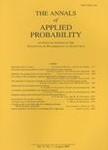-
作者:Krieger, Abba M.; Pollak, Moshe; Samuel-Cahn, Ester
作者单位:University of Pennsylvania; Hebrew University of Jerusalem
摘要:In many situations, the decision maker observes items in sequence and needs to determine whether or not to retain a particular item immediately after it is observed. Any decision rule creates a set of items that are selected. We consider situations where the available information is the rank of a present observation relative to its predecessors. Certain natural selection rules are investigated. Theoretical results are presented pertaining to the evolution of the number of items selected, measu...
-
作者:Jones, Matthew O.; Serfozo, Richard F.
作者单位:Austin Peay State University; University System of Georgia; Georgia Institute of Technology
摘要:We present sufficient conditions for sums of dependent point processes to converge in distribution to a Poisson process. This extends the classical result of Grigelionis [Theory Probab. Appl. 8 (1963) 172-182] for sums of uniformly null point processes that have Poisson limits. Included is an application in which a particle-survivor point process converges to a Poisson process. This result sheds light on the surprising Poisson limit of the species competition process of Durrett and Limic.
-
作者:Bai, Z. D.; Silverstein, Jack W.
作者单位:Northeast Normal University - China; North Carolina State University
摘要:Let {s(ij): i, j = 1,2....} consist of i.i.d. random variables in C with Es-11 = 0, E/s(11)/(2) = 1. For each positive integer N, let s(k) = s(k) (N) = (s(1k), s(2k),..., s(Nk))(T), 1 <= k <= K, with K = K(N) and K/N -> c > 0 as N -> infinity. Assume for fixed positive integer L, for each N and k <= K, alpha(k) = (alpha(k)(1),..., alpha k(L))(T) is random, independent of the s(ij), and the empirical distribution of (alpha(1),..., alpha(K)), with probability one converging weakly to a probabili...
-
作者:Yin, George; Zhang, Hanqin
作者单位:Wayne State University; Chinese Academy of Sciences; Academy of Mathematics & System Sciences, CAS
摘要:This work focuses on time-inhomogeneous Markov chains with two time scales. Our motivations stem from applications in reliability and dependability, queueing networks, financial engineering and manufacturing systems, where two-time-scale scenarios naturally arise. One of the important questions is: As the rate of fluctuation of the Markov chain goes to infinity, if the limit distributions of suitably centered and scaled sequences of occupation measures exist, what can be said about the converg...

